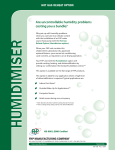
advertisement

16 | Application Considerations
Geothermal Systems
Closed loop and pond applications require specialized design knowledge. No attempt at these installations should be made unless the dealer has received specialized training. Utilizing the Ground
Loop Pumping Package (GLP), makes the
SM CS Series Heat Pump
installation easy. Anti-freeze solutions are utilized when low evaporating conditions are expected to occur. Refer to the GLP installation manuals for
more specific instructions. (Figure #11)
[1] Line voltage disconnect (unit)
[2] Flex duct Connection
[3] Low voltage control connection
[4] Line voltage connection (unit)
[5] P/T ports
[6] Vibration pad
[7] Condensate drain connection
[8] Ground loop connection kit
[9] Ground loop pumping package
[10] Polyethylene with insulation
[11] Line voltage disconnect (electric heater)
Figure # 11
Diagram shows typical installation and is for illustration purposes only. Ensure access to
Heat Pump is not restricted.
8 733 920 846 (2015/01) Subject to change without prior notice SM CS Series Heat Pump
SM CS Series Heat
SYSTEM CHECKOUT
After completing the installation, and before energizing the unit, the following system checks should be made:
1. Verify that the supply voltage to the heat pump is in accordance with the nameplate ratings.
2. Make sure that all electrical connections are tight and secure.
3. Check the electrical fusing and wiring for the correct size.
Ensure cabinet and Electrical Box are properly grounded.
4. Verify that the low voltage wiring between the thermostat and the unit is correct.
5. Verify that the water piping is complete and correct.
6. Check that the water flow is correct, and adjust if necessary.
7. Check the blower for free rotation, and that it is secured to the shaft.
8. Verify that vibration isolation has been provided.
9. Unit is serviceable. Be certain that all access panels are secured in place.
Considerations:
• Always check incoming line voltage power supply and secondary control voltage for adequacy. Transformer primaries are dual tapped for 208 and 230 volts. Connect the appropriate tap to ensure a minimum of 18 volts secondary control voltage. 24 volts is ideal for best operation.
• Long length thermostat and control wiring leads may create voltage drop. Increase wire gauge or up-size transformers may be required to insure minimum secondary voltage supply.
• FHP recommends the following guidelines for wiring between a thermostat and the unit: 18
GA up to 60 foot, 16 GA up to 100 ft and 14 GA up to 140 ft.
• Do not apply additional controlled devices to the control circuit power supply without consulting the factory. Doing so may void equipment warranties.
• Check with all code authorities on requirements involving condensate disposal/ over flow protection criteria.
UNIT START-UP
System Checkout | 17
1. Set the thermostat to the highest setting.
2. Set the thermostat system switch to “COOL”, and the fan switch to the “AUTO” position. The reversing valve solenoid should energize. The compressor and fan should not run.
3. Reduce the thermostat setting approximately 5 degrees below the room temperature.
4. Verify the heat pump is operating in the cooling mode.
5. Turn the thermostat system switch to the
“OFF” position. The unit should stop running and the reversing valve should de energize.
6. Leave the unit off for approximately (5) minutes to allow for system equalization.
7. Turn the thermostat to the lowest setting.
8. Set the thermostat switch to “HEAT”.
9. Increase the thermostat setting approximately
5 degrees above the room temperature.
10. Verify the heat pump is operating in the heating mode.
11. Set the thermostat to maintain the desired space temperature.
12. Check for vibrations, leaks, etc.
MAINTENANCE
1. Filter changes or cleanings are required at regular intervals. The time period between filter changes will depend upon type of environment the equipment is used in. In a single family home, that is not under construction, changing or cleaning the filter every 60 days is sufficient. In other applications such as motels, where daily vacuuming produces a large amount of lint, filter changes may need to be as frequent as biweekly.
Equipment should never be used during construction due to likelihood of wall board dust accumulation in the air coil of the equipment which permanently affects the performance and may shorten the life of the equipment.
Revised 01-15 8 733 920 846 (2015/01)
advertisement
* Your assessment is very important for improving the workof artificial intelligence, which forms the content of this project
Related manuals
advertisement
Table of contents
- 3 Model Nomenclature
- 3 Key to Symbols
- 3 Safety Warnings
- 4 Standard SM CS package
- 4 GENERAL DESCRIPTION
- 4 MOVING AND STORAGE
- 4 INITIAL INSPECTION
- 4 LOCATION
- 4 Condensing Section
- 5 Air Handler
- 5 PIPING
- 6 ELECTRICAL
- 6 Safety Devices and the UPM Controller
- 10 OPTIONS
- 10 Heat Recovery Package (HRP)
- 10 DPS Water Flow Proving
- 10 Pump Relay
- 10 Comfort Alert Module
- 11 HEAT RECOVERY PACKAGE
- 11 Water Tank Preparation
- 11 HR Water Piping
- 12 Water Tank Refill
- 12 Initial Start-Up
- 13 SEQUENCE OF OPERATION
- 13 Cooling Mode
- 13 Heating Mode
- 15 APPLICATION CONSIDERATIONS
- 15 Well Water Systems
- 16 Cooling Tower/Boiler Systems
- 18 Geothermal Systems
- 19 SYSTEM CHECKOUT
- 19 UNIT START-UP
- 20 MAINTENANCE
- 21 UNIT CHECK-OUT SHEET
- 22 TROUBLESHOOTING
- 25 Unit Lockouts
- 26 OPERATING TEMPERATURES AND PRESSURES
- 31 WATER SIDE PRESSURE DROP TABLE
- 32 WIRING DIAGRAMS
- 33 DIMENSIONAL DRAWINGS
- 34 SPARE PARTS LIST
- 35 CS Parts List - Cabinet
- 36 CS Parts List -Refrigeration/Electrical
- 39 Notes
